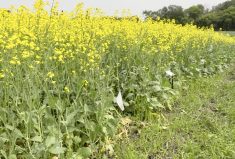The Manitoba Canola Growers Association president has a new crop he wants to see researched and developed with some of the $2.4 million it collected through farmer checkoffs last year. No, not a new type of canola. Young leaders.
The association has just recently completed an extensive review and rewrite of its bylaws. There is now a limit on how many consecutive terms a director can serve.
That provision is intended to ensure the association gets new blood into its leadership. But from where?
The association’s board table is filled with individuals who are nearing the end of their farming careers. What’s more, all of those individuals were groomed for their current roles by their involvement as delegates and directors with the now-defunct grain co-operatives.
Read Also

Manitoba Ag Days plans star-studded speaker lineup
Dragons’ Den panellist Arlene Dickinson among speaker series highlight for 2026 Manitoba Ag Days in Brandon, alongside slate of agriculture experts.
The delegate structure and the fact that farmers had a vested interest in the business affairs of the co-operative ensured their involvement. It was these organizations that helped them develop their skills – and the interest – in representing farmers through the organizations they belong to today.
It was at their annual meetings that farmer delegates learned the arcane but useful Roberts Rules of Order, still the most effective means of civilized and respectful discussion within a democratic organization. And just as importantly, it was where farmers – not to mention a few farm journalists covering the meetings – gained an in-depth understanding of the industry in which they operate.
A decade after their collapse, the human-development gap is becoming apparent. Many of the younger farmers nowadays don’t seem to have time to mail in a vote when consulted on the affairs of their organization or to elect the people to run them, let alone attend the annual meeting or step in to the leadership role.
This is not unique to agriculture. Voter turnout in recent federal elections would suggest the youth of our society are proportionately disengaged with the democratic process.
In an April, 2010 report to Parliament, the Parliamentary Information and Research Service noted that voter turnout in federal elections has been steadily declining since 1993, reaching an all-time low of 58.8 per cent of eligible voters casting ballots in 2008.
“During the same time frame, Canada’s youngest voters have turned out for federal general elections in numbers estimated to be well below the voter turnout rate for all age groups,” the report said. “In fact, findings in recent studies indicate that these youngest cohorts, as they age, are voting in lower numbers than their equivalent age cohorts did in the past.
“In other words, the… conventional wisdom that non-voters become voters as they age may no longer hold, and this may have long-lasting implications for voter participation in Canada.”
While the canola growers’ plight is not unique, it is still a problem that must be addressed for the long-term health of the organization.
Some may take exception to the idea of using farmer checkoff funds, which were initially set up to help finance crop development, to promote more farmer involvement instead.
To those farmers we say, “Haul yourself down to the next meeting and do something about it.”
Cash Receipts And Profitability
The Canola Council of Canada has set a stellar example of private sector extension in recent years. With a team of agronomists situated across Western Canada, it offers professional, independent advice and support to farmers for everything from seed treatments to storage.
But the council, which of course represents the whole value chain, has also set a lofty goal of producing 15 million tonnes of canola in Canada by 2015.
A recent press release from the council leads us to believe that that target, driven by members that export or crush canola, sell farmers seed and supply crop protection, has clouded its judgment.
The Feb. 24 release crows that canola was the No. 1 crop for cash receipts in Canada, which we don’t doubt. What we take issue with is equating farm cash receipts with profitability. “Farmers are business people and they make decisions based on profitability,” the release says.
The council had better hope farmers don’t make their production decisions this year based on profitability. Because if they do, they won’t be growing canola.
Based on Manitoba Agriculture’s Crop Production budgets for variable costs, average yields and recent market prices, canola ranks fifth on the profitability scale, behind oats, confectionery sunflowers, corn, and flax. The only crops it beats out are Roundup Ready soybeans, wheat and barley.
That said, every crop on the list this year is showing positive net-over- operating returns – a far cry from a few years back when it was hard to pencil out a profit on anything.
That suggests that this would be a good year for farmers to pursue profitability through rotations based on good agronomy – not farm cash receipts. [email protected]














